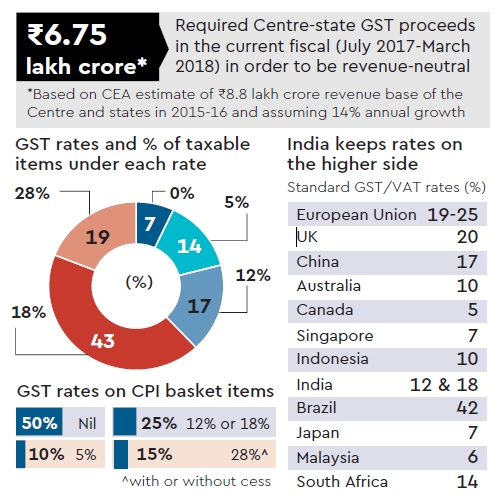
The rumour mills have gone on an overdrive mode since the launch of GST.
Here’s a reality check for both GST supporters and its detractors.
- Now it’s one nation one tax
Myth : Since GST will replace all other taxes on all goods and services, we are in a single tax regime.
Reality : Though this was the original idea, certain exempted items such as petroleum products, are still outside GST’s ambit and, therefore, their tax rates vary significantly across states.
For example, petrol is still sold in Mumbai at Rs 74.30 per litre (as on 5 July) compared to Rs 63.12 in New Delhi. Similarly, some other items, such as liquor, have also been kept out of GST for now.
2. Small businesses will suffer
Myth : The life of small businessmen will become difficult under GST because of computerised billing, need for Internet connectivity.
Reality : Shops can do manual billing under GST and Net connectivity is needed only at the time of filing monthly return and can be managed from a cyber cafe.
- Prices will shoot up
Myth : Personal expenses will go up on account of GST making it inflationary because tax rates have been fixed at higher levels—18%, 28%.
Reality : Though the GST rates seem high, it is only because the entire tax is now visible to the consumer. Earlier most taxes – central and state excise, additional excise, purchase tax, etc. – did not reflect on your bill. If one adds up all the taxes, it would have been more for most items (ie effective tax rates under GST will be lower for most products).
For example, the price of chicken dish in Kerala should fall because there was a 14.5% tax on live chicken earlier, which has come down to zero now under GST.
4. Corporates may try to profiteer but govt won’t
Myth : Business will try to rob you of the GST benefits, but the government won’t make money at your expense.
Reality : Some state governments are also acting greedy and not passing on the GST benefits to consumers. For example, the Maharashtra government has increased the vehicle registration tax by 2% after auto firms passed on the GST benefit by cutting prices by 2-3%.
5. No tax other than GST is now a reality
Myth : For every good or service that has been brought under GST, there won’t be any additional tax.
Reality : GST only subsumes central and state taxes and the levies charged by local bodies are still outside its ambit. Using this loophole, the Tamil Nadu government has allowed its local bodies to charge 30% tax on movie tickets over and above GST. GST is 18% for movie tickets up to Rs 100 and 28% for tickets that cost more than Rs 100.
But because of local body levies, tax in Tamil Nadu will be 48% for tickets up to Rs 100 and 58% for tickets that cost more. Not surprisingly, the cinema hall owners in the state went on strike. “Action of the Tamil Nadu government is against the spirit of the GST and the GST council should take action against it,” says Amit Sarkar, Partner and Head, Indirect Taxes, BDO India.
6. Economic growth will rise
Myth : GST will push up the economic growth.
Reality : Real economic growth comes from both organised and unorganised sectors. Tax evasion becomes difficult in GST, so cost advantage of unorganised sector goes and this will result in some businesses shifting to the organised sector. So, what happens will not be an in increase in ‘real’ economic growth but an increase in ‘recorded’ economic growth. However, there will be a small uptick in ‘real’ economic growth due to the improvement in the ease of doing business.
7. Pay GST twice for card payments
Myth : GST will be charged twice, if you make payments via credit card.
Reality : There is no additional GST for credit card payments and the confusion arose only because there is GST on additional fees—convenience charges—levied by companies. For example, you make Rs 10,000 payment and a company charges Rs 50 as convenience fee for helping you make the payment via the credit card, you have to pay 18% GST on that fee too—earlier you paid a 15% tax on it. So the 3% increase is very small—just Rs 1.5 on Rs 50.
Source: http://economictimes.indiatimes.com/articleshow/59501148.cms


